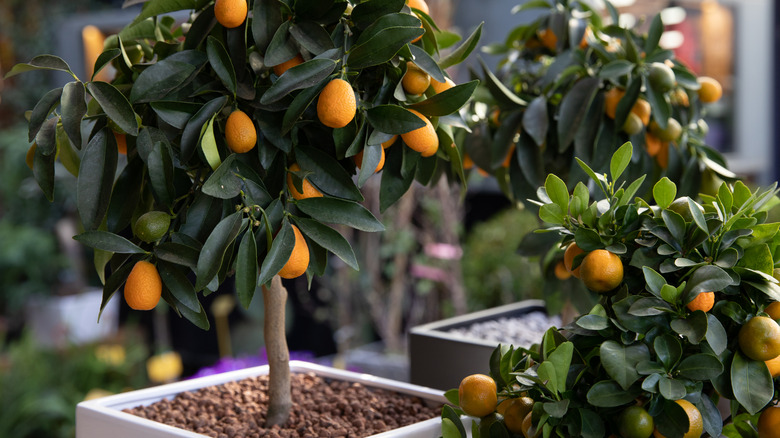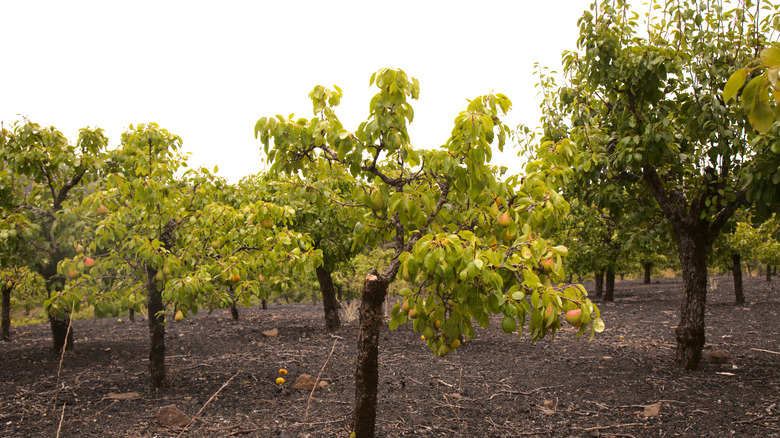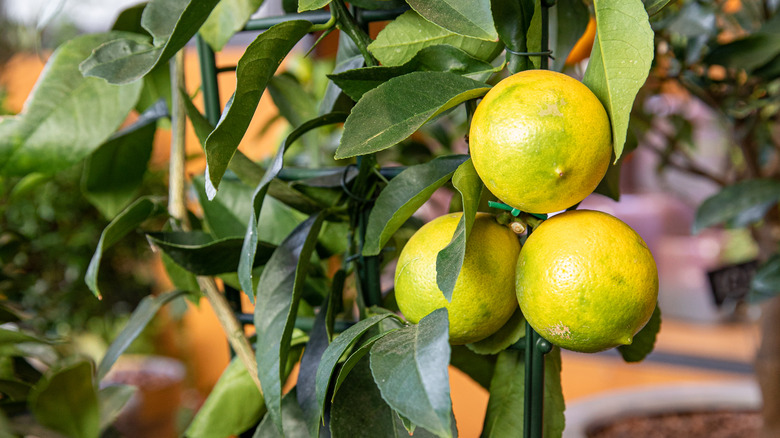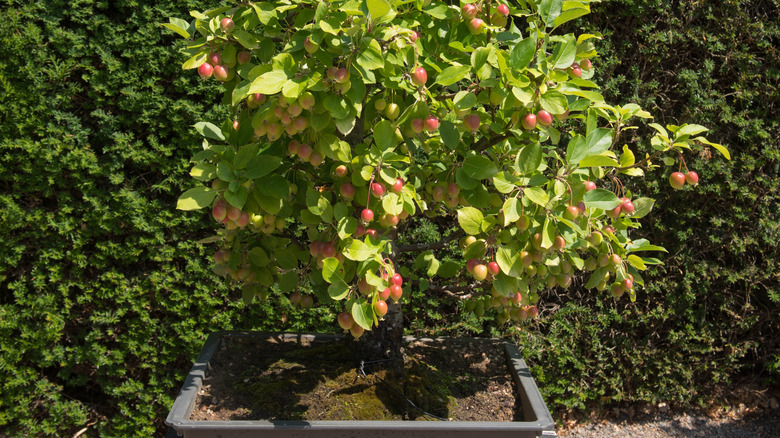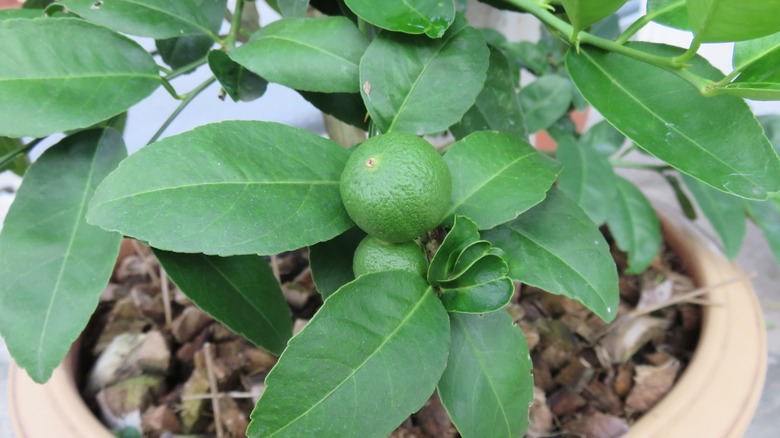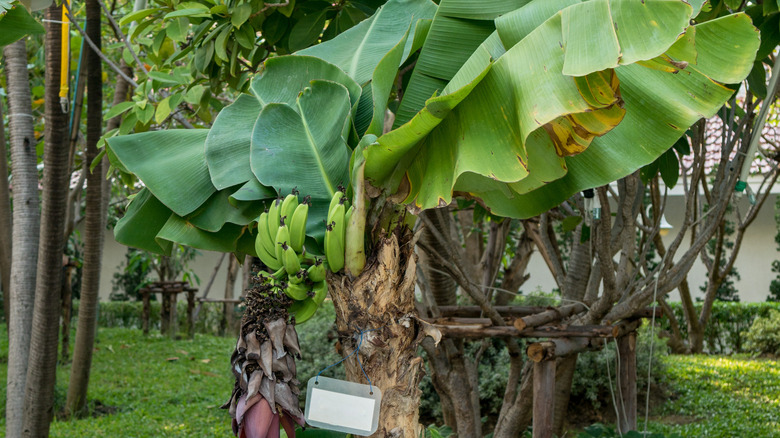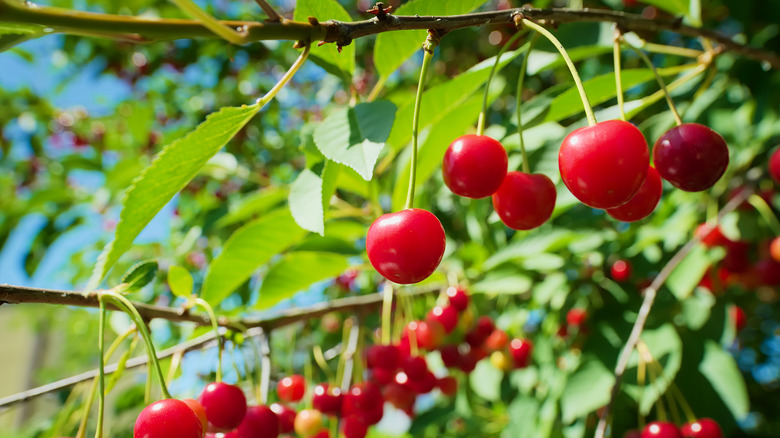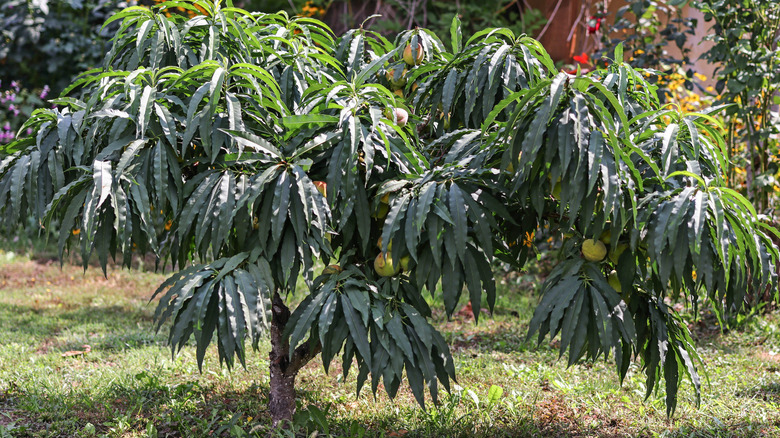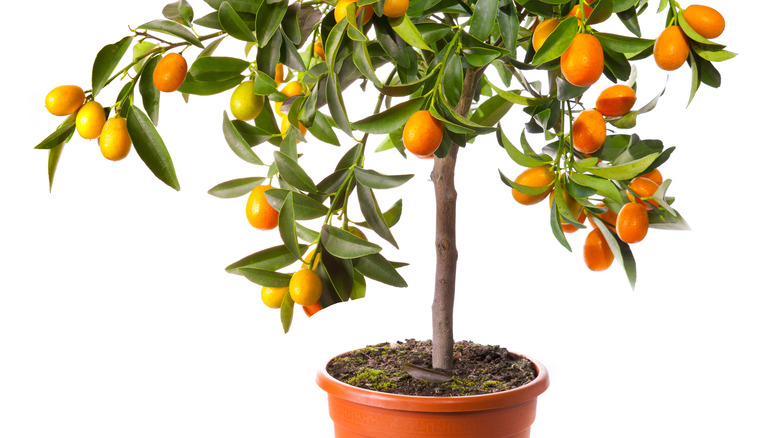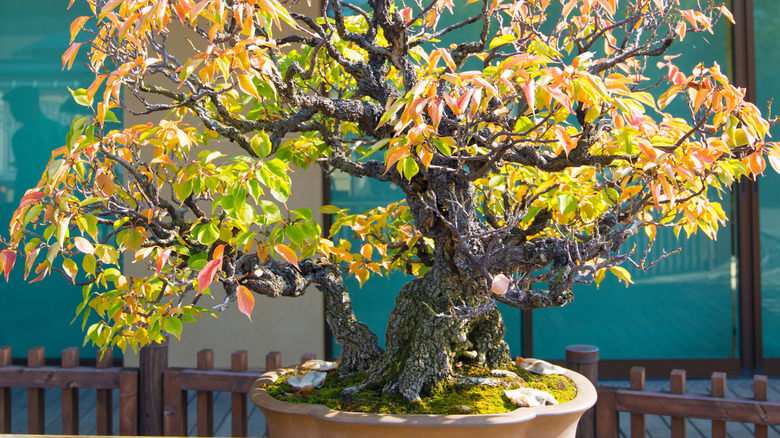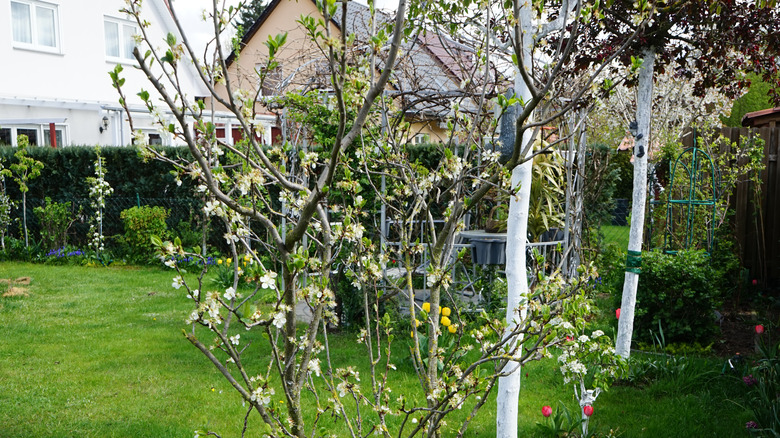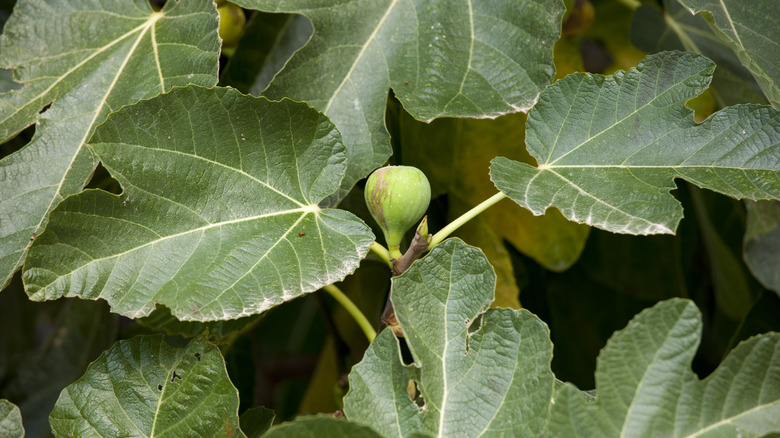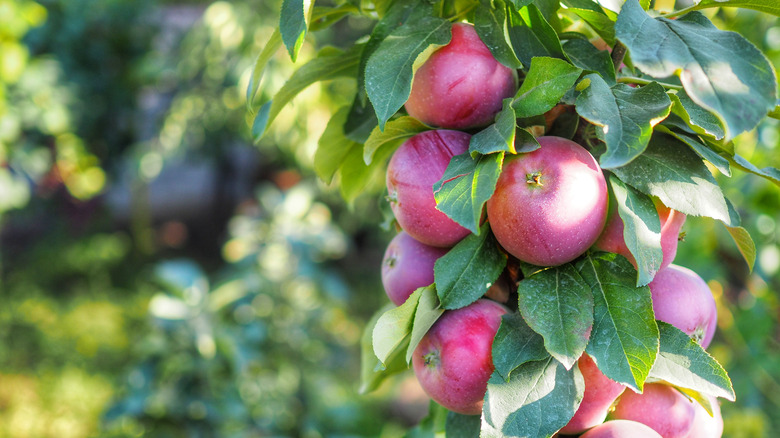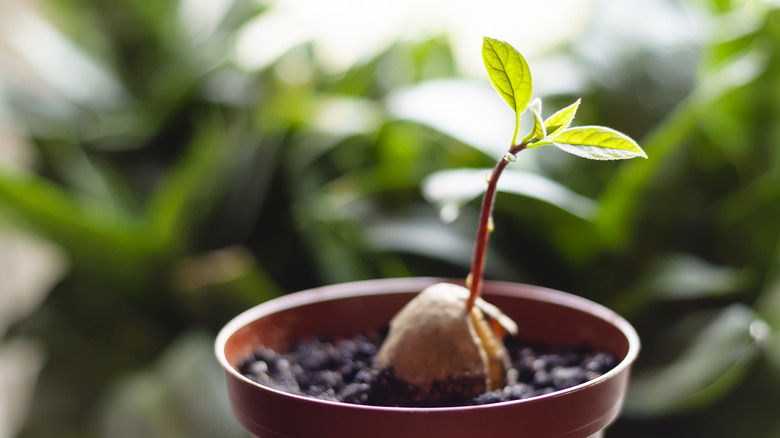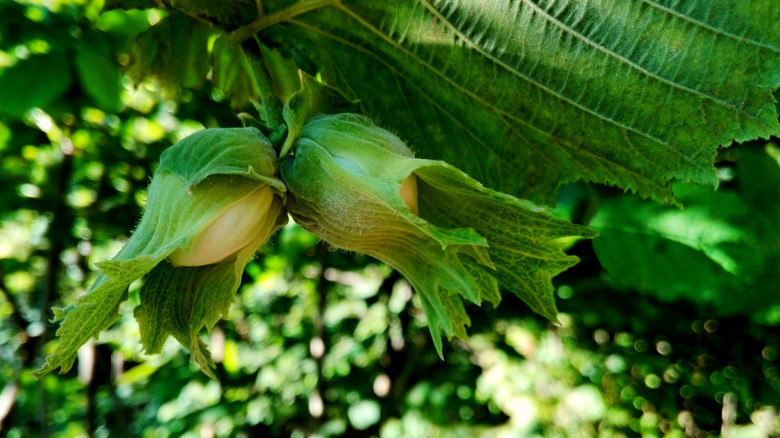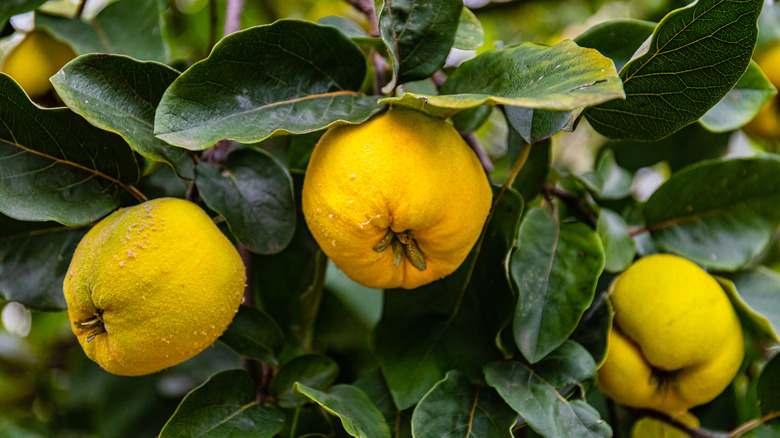15 Dwarf Fruit Trees That Are Perfect For A Smaller Yard
Fresh fruit is incomparable in taste, texture, aroma, and color. Many fruits available in your supermarket produce section have travelled and ripened over time, producing a different result than those items fresh off the tree. Unfortunately, many of us don't have large yards in which to grow our own orchards to ensure these tree-to-table treats are widely available.
While it may be difficult to cultivate large fruit trees at home, the good news is there are many smaller varieties available that can be worked into even a tiny yard, and even some fruits that will grow in pots that can be supported on backyard patios too. Dwarf fruit trees can often produce enough fruit to easily fulfill a family's needs, and are a fabulous alternative to traditional, larger varieties, according to SF Gate.
Discover these 15 varieties of fruit tree to find the right one for your home. Fragrant flowers and tasty treats will soon be within reach.
1. Dwarf pear trees
Pears are one of the easier to grow fruit trees, but a full pear tree can take up over 25 feet of space. In addition to a smaller footprint in your yard, a shorter tree means easier to pick fruit. Dwarf pears are available in multiple different varieties, so you'll still get the fun of choosing your favorite fruit.
This is My Garden recommends a dwarf pear tree that can be grown with only 10 to 15 feet of space and may only reach between 10 and 12 feet tall in size. Seasonal flowers bloom in April to May and fruit by late August; the tree thrives in USDA growing zones 5 through 8 with well-drained soil type. Growing conditions require planting at least two trees for cross pollination.
2. Dwarf lemon tree
You commonly see dwarf lemon trees in patio-sized pots, although these plants will eventually grow larger. Crate and Basket describes three main varieties of dwarf lemons. Meyer lemons are more of an orangey lemon-orange hybrid, known for sweetness and floral, aromatic flowers. Eureka lemons resemble the bright yellow standard lemons you see in stores. Lisbon lemons are the yellow cousin of the Eureka, with a more dimpled shape and extra juice.
Dwarf lemons will typically grow from 8 to 10 feet tall compared with the 20 foot tall standard variety. Bloom Season is not set as fruit can often be harvested year-round (via Monrovia), as these citrus are well-suited to warm climates like USDA growing zones 9 through 10. Growing conditions include full sun; water regularly using a standard fruit tree and vine soil type mix.
3. Crab apple bonsai tree
Bonsai Empire shares that crab apples are the most popular apple tree for creating a beautiful, fruit bearing bonsai. A bonsai will have apples that may appear closer to the size of cherries. Crab apples are still apples, just a smaller and very tart variety (via Ted Gardens). These apples are also native to North America.
Bonsai experts recommend choosing varieties including Malus halliana, Malus x zumi, Malus toringo, Malus sylvestris, Malus floribunda, Malus baccata, and Malus cerasifera. Bloom season is in mid to late spring with fruit afterwards (via Florgeous), even for plants that may not get larger than 6 to 10 inches in size. USDA growing zone is open if brought indoors during extreme temperatures, and growing conditions require regular watering during fruiting and full sun; avoid acidic soil types.
4. Dwarf lime tree
If you're looking to put the "lime in the coconut," a dwarf lime tree may be the right fit for you. While considered a low-maintenance fruit tree, potted limes are still tropical, and dwarf potted varieties can make it easier to bring these inside for the winter in colder climates.
Experts at Citrus describe dwarf lime trees as growing 6 to 10 feet in size when planted in the ground, but these trees will stay even shorter if left in a pot. Spring is the natural bloom season, but warm USDA growing zones of 9 to 10 or indoors can extend flowering (via Gardens Alive). Plant in a sandy soil type in growing conditions that include full sun to partial shade.
5. Dwarf banana tree
The dwarf banana of choice for the U.S. is the Cavendish banana because it can survive in almost any hardiness zone. Just remember to have patience with banana trees, as it will take up to 15 months for the tree to flower, and an additional 2 to 6 months after that to enjoy your first fruits.
This Old House elaborates that the plant will create a stalk of 8 to 10 feet in size and grow fruit from 6 to 10 inches long. Banana trees can be planted in the ground in warmer U.S. climates and in pots for areas with hard freezes, so focus on USDA growing Zones 9 to 11 outdoors or 4 to 11 if potted. Bloom season can be year round but intermittent, although these plants are self-pollinating and well suited to growing conditions of sun and moist soil.
6. Dwarf cherry tree
A dwarf cherry tree is different from a cherry shrub, although both are excellent options for urban growers according to Orchard People. Dwarf cherry trees can still gain significant size if not tended, but offer a larger variety of fruits than a standard shrub, making both sweet and tart cherries available to backyard growers. Example cultivars include names like Romeo, Juliet, Crimson Passion, Valentine, and Cupid for sour shrubs, or the more common Bing, Lapins, or Ranier for a dwarf tree.
Cherry bloom season is typically in the spring when grown in USDA growing zones 2 to 7 (via Gurney's). Growing conditions include full sun and self-pollinating plants in a soil type that stays well drained. Dwarf cherries trees may reach 5 to 7 feet in size, although bushes may be smaller.
7. Dwarf peach tree
If you want to celebrate stone fruit season in style, a dwarf peach tree is for you. However, Garden Tech experts warn that this backyard fruit may not be the best for beginners as it requires specific hot and cold growing periods, timed pest control, and disease control management.
Peach trees tend to require training, pruning, or thinning for optimal yields but are self-pollinating. Peaches do require a cool period in the winter for optimal fruiting followed by a bloom season in the spring. Peaches grow best in USDA growing zones 5 through 9 (via Kellogg's Garden Organics) and will reach a size of 8 to 10 feet in a well-drained soil type.
8. Dwarf orange tree
There are many varieties of dwarf orange to choose from including Campbell Valencia and Washington Navel for standard oranges; Clementine, Satsuma, and Tango for mandarins; and you can even grow the semi-dwarf Moro blood orange or the Smith Red, according to Fine Gardening experts.
Suited to warmer climates such as USDA growing Zones 8 to 11 or 4 to 11 on the patio, many prefer to keep these trees potted so they can be moved inside and outside seasonally (via Fast Growing Trees). Growing conditions including full sun and a well-drained soil type with a regular watering schedule have seen year-round harvests of fruit yielding a year-long bloom season. Dwarf oranges may average 8 feet in size.
9. Bonsai apricot tree
Dwarf apricot trees can be 8 to 10 feet in size, such as the Garden Annie fruits, which Willis Orchards describe as having "firm medium to large fruits with bright yellow skin." Dwarf apricots are suited to USDA growing zones 5 to 9 and require growing conditions with a cooling off period for overwintering. Potted apricots are popular in Japan, growing about 2 feet in size using a soil type like Bonsai potting mix, and the bloom season can be as early as January (via Bonsai). For all bonsais, seek full sun and avoid severe temperatures.
10. Dwarf plum tree
Dwarf plum trees celebrate a bloom season in spring yielding delicious summer to fall fruits. Grow Veg gardeners caution, however, that not all dwarf plums are self-pollinating, so make sure to read the fine print before ordering including your preferred fruit type, such as Italian plums or yellow plums. Growing around 8 to 10 feet in size, some dwarf plums may reach as tall as 15 feet (via SF Gate). Soil types of clay or loam are well suited, as are growing conditions including sunny, well-circulated air in USDA growing zones 3 to 8 (per SF Gate).
11. Dwarf fig tree
While technically a dwarf, be cautioned that figs can still end up rather large, as the Tribune advises even the dwarf variety can grow up to 15 feet tall in size. Additionally, a fun fact about fig trees is that they typically grow equally wide as they do tall. A good variety for gardeners with a small backyard is the Brown Turkey, know for being both smaller and heartier than many other types.
Smaller figs like the Celeste may be closer to 8 to 10 feet in size and are adaptable to many soil types (via Planting Trees). Growing conditions include full sun and regular watering with spring blooms in USDA growing zones 8 to 10 (or 5 to 7 depending on type).
12. Columnar apple trees
Columnar apples are fruit trees trained to grow straight up from 8 to 11 feet but only spread about 2 feet wide, creating a column of apples as described by Fine Gardening. Three primary varieties of columnar apples that are popular include Northpole, which resembles traditional McIntosh apples; Golden Sentinel, which is similar to Golden Delicious; and Scarlet Sentinel, describes as "green-yellow apples with a red blush."
Columnar apples' bloom season is the same as standard apples, and USDA growing zones 4 to 9 are ideal. Growing conditions will, however, require two trees for pollination, and you may need to prune fruits for plant stability. Grow in full sun with a soil type that is neither soggy nor bone dry (via Gardening Know How).
13. Potted avocado trees
Yes, avocados are actually a fruit, but a standard avocado tree can grow as tall as 80 feet, so you definitely want to check the fine print on this one. SF Gate advises that there is exactly one true dwarf avocado called the Wurtz or the "Mini Cado," which will stop by 10 feet high.
A dwarf avocado will typically reach 8 to 10 feet in size at maturity, and given proper growing conditions including full sun or light shade with a soil type that holds moisture, possibly including mulch. Avocado bloom season is in late winter or early spring, and the tree grows best in warm climates such as USDA growing zones 8 to 11 or indoors (via Homestead and Chill). Avoid frosts.
14. Dwarf hazelnut tree
Hazelnuts are also actually a fruit, although we generally classify these as a nut. Hazelnuts can be grown as a single stem tree or allowed to spread and create a "hazel bush," according to Cornell's Small Farm program. Bloom season is in spring, although hazelnuts are generally adaptable to most soil types and can tolerate a wide range of temperatures.
Growing conditions may require extra care of the plant itself, as hazelnut growers will typically need two trees to cross pollinate. However, hazelnut trees will send out shoots (often called suckers) that help generate new tree "clones." Hazelnut growers should be aware that these trees are highly attractive to animals, so take care with your crop. Mature bushes will reach 8 to 12 feet in size and are suited to USDA growing zones 7 to 8, although some varieties list zones 5 to 7 (via Fast Growing Trees).
15. Dwarf quince tree
Quince is described by Ison's Nursery & Vineyards as having a lemony scent with a hint of green apple, but the taste is a crisp textured mix of apple, pineapple, and pear for a truly unique backyard variety. Valued as an ornamental for fragrant blooms and vibrant colored fruit, these dwarf trees like the Rich Dwarf quince tree are also high producers of an edible bounty in the fall.
Quince bloom season is spring to summer with fruit ripening in October. Growing conditions include 1/2 day to full day sun, and the plant is self-fertile (or self-pollinating) and suited to most soil types. Dwarf quince will reach 10 to 12 feet in height and are best in USDA growing zones 5 to 9.
